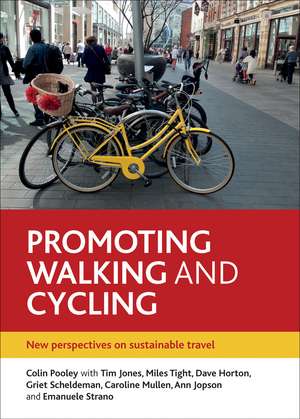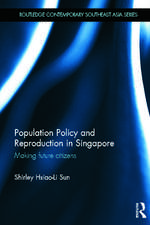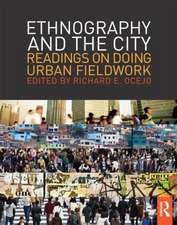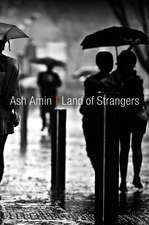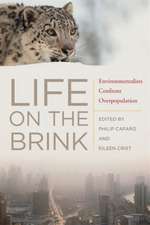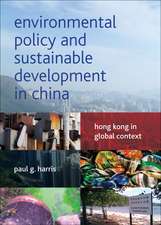Promoting Walking and Cycling: New Perspectives on Sustainable Travel
Autor Colin Pooleyen Limba Engleză Paperback – 20 aug 2013
Why, despite the supposed desirability of cycling and walking, do so many people feel unable or unwilling to incorporate these modes of transport into their everyday journeys? This problem, one of the most pressing questions facing transport planners, has major implications for environmental policy, urban planning, and existing social and economic structures. Drawing on original research, the authors reveal the reasons behind our resistance and suggest evidence-based policy solutions that could significantly increase levels of walking and cycling. These informed perspectives will enlighten urban planners and policymakers, as well as students and scholars of transport and mobility issues.
| Toate formatele și edițiile | Preț | Express |
|---|---|---|
| Paperback (1) | 355.32 lei 22-36 zile | |
| Bristol University Press – 20 aug 2013 | 355.32 lei 22-36 zile | |
| Hardback (1) | 831.19 lei 43-57 zile | |
| Bristol University Press – 20 aug 2013 | 831.19 lei 43-57 zile |
Preț: 355.32 lei
Nou
Puncte Express: 533
Preț estimativ în valută:
67.99€ • 71.18$ • 56.26£
67.99€ • 71.18$ • 56.26£
Carte disponibilă
Livrare economică 17-31 martie
Preluare comenzi: 021 569.72.76
Specificații
ISBN-13: 9781447310082
ISBN-10: 144731008X
Pagini: 320
Ilustrații: 6 figures, 42 tables
Dimensiuni: 171 x 241 x 15 mm
Greutate: 0.41 kg
Ediția:New.
Editura: Bristol University Press
Colecția Policy Press
ISBN-10: 144731008X
Pagini: 320
Ilustrații: 6 figures, 42 tables
Dimensiuni: 171 x 241 x 15 mm
Greutate: 0.41 kg
Ediția:New.
Editura: Bristol University Press
Colecția Policy Press
Notă biografică
Colin Pooley is professor of social and historical geography in the Lancaster Environment Centre at Lancaster University.
Cuprins
Lists of maps, tables and boxes
About the authors
Acknowledgements
Preface
Section I: Context
1 Setting the scene and defining the problem
Setting the scene
Promoting sustainable mobility in Britain
Academic perspectives
Conclusions
2 Where have we come from? The historical context
How did we travel in the past and what has changed?
The changing role of the bicycle in Britain
The historical dominance and persistence of walking
Conclusions: issues of path dependency
3 The global context: how is Britain different from other places?
Urban travel outside the UK
Places where walking is normal
Places where cycling is normal
Conclusions: Britain in a global context
Section II: The research
4 Researching walking and cycling
The UWAC approach: introduction to the data
The case study communities
The limitations: what the research cannot be used to show
5 How the built environment influences walking and cycling
Context: the built environment and sustainable travel
The connectivity of the street network and access to facilities
Spatial analysis of travel and transport: principles and problems
Evaluating associations between street network connectivity, access to everyday activities and walking and cycling
Conclusions and evaluation
6 What do people think about everyday travel in urban areas?
Introduction
What do people say about how they travel?
What do people say about how they would like to travel?
How do people feel and relate to travel?
Conclusions
7 The place of walking in the urban environment
Why people walk
How people walk
The barriers to walking
Conclusions: building walking cultures
8 The role of cycling in the urban environment
Why people cycle
How people cycle
The barriers to cycling
Conclusions: building cycling cultures
Section III: Policy Perspectives
9 The future of walking and cycling in British urban areas
Strategies for making walking normal
Strategies for making cycling normal
Making it all happen: issues of implementation
10 Conclusions: issues of society, economy and sustainability
Connecting walking and cycling to wider society
What is working now?
What is the risk of doing nothing?
What could be done?
Concluding comments
References
Websites
Index
About the authors
Acknowledgements
Preface
Section I: Context
1 Setting the scene and defining the problem
Setting the scene
Promoting sustainable mobility in Britain
Academic perspectives
Conclusions
2 Where have we come from? The historical context
How did we travel in the past and what has changed?
The changing role of the bicycle in Britain
The historical dominance and persistence of walking
Conclusions: issues of path dependency
3 The global context: how is Britain different from other places?
Urban travel outside the UK
Places where walking is normal
Places where cycling is normal
Conclusions: Britain in a global context
Section II: The research
4 Researching walking and cycling
The UWAC approach: introduction to the data
The case study communities
The limitations: what the research cannot be used to show
5 How the built environment influences walking and cycling
Context: the built environment and sustainable travel
The connectivity of the street network and access to facilities
Spatial analysis of travel and transport: principles and problems
Evaluating associations between street network connectivity, access to everyday activities and walking and cycling
Conclusions and evaluation
6 What do people think about everyday travel in urban areas?
Introduction
What do people say about how they travel?
What do people say about how they would like to travel?
How do people feel and relate to travel?
Conclusions
7 The place of walking in the urban environment
Why people walk
How people walk
The barriers to walking
Conclusions: building walking cultures
8 The role of cycling in the urban environment
Why people cycle
How people cycle
The barriers to cycling
Conclusions: building cycling cultures
Section III: Policy Perspectives
9 The future of walking and cycling in British urban areas
Strategies for making walking normal
Strategies for making cycling normal
Making it all happen: issues of implementation
10 Conclusions: issues of society, economy and sustainability
Connecting walking and cycling to wider society
What is working now?
What is the risk of doing nothing?
What could be done?
Concluding comments
References
Websites
Index
Recenzii
“This pioneering book is much needed, as it calls for a new understanding of travel and a real engagement with people and policy makers, so that effective actions can be taken that will transform the quality of the urban environment.”
“This book addresses one of the major lifestyle challenges of our age—how to embed sustained and sustainable mobility within community and society. The learning assembled will be essential to the effective design and implementation of policies and interventions.”
